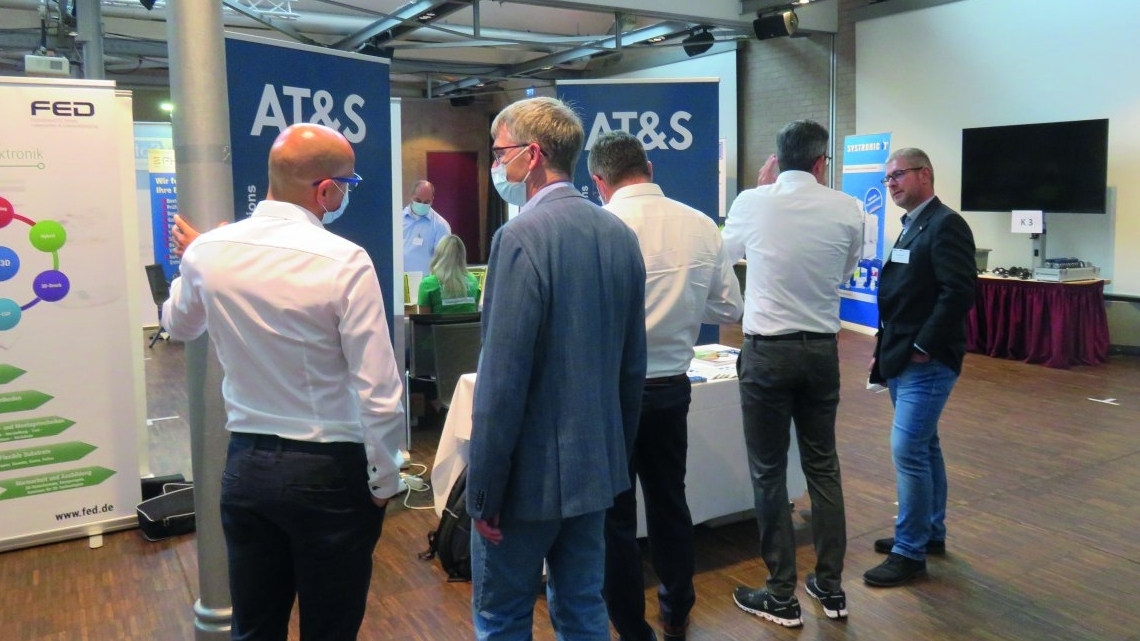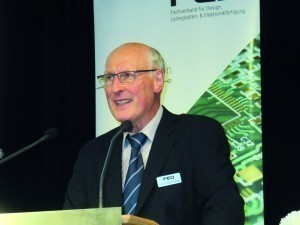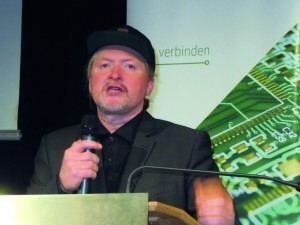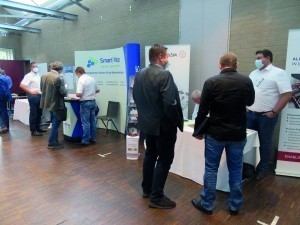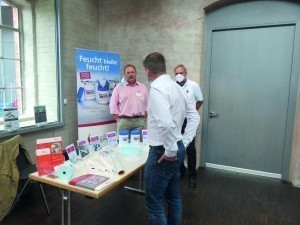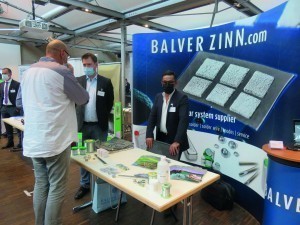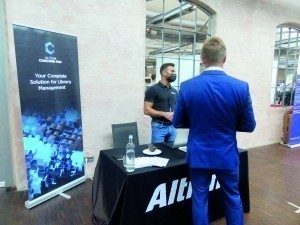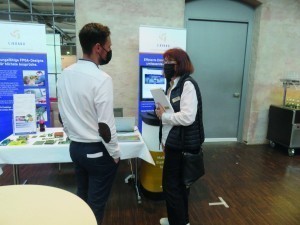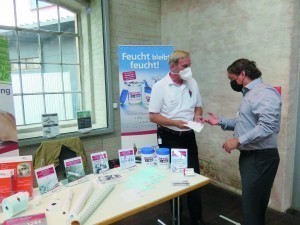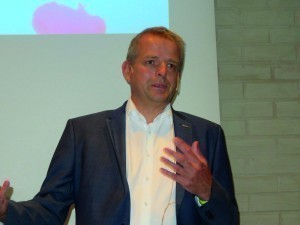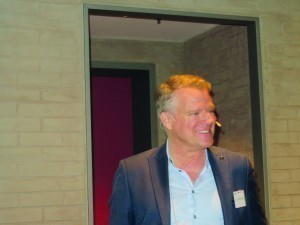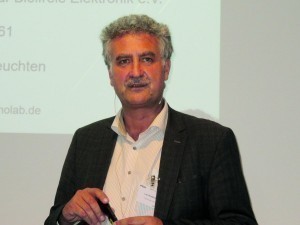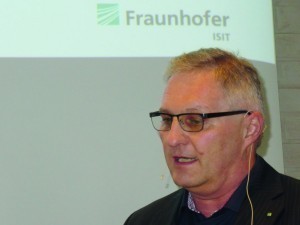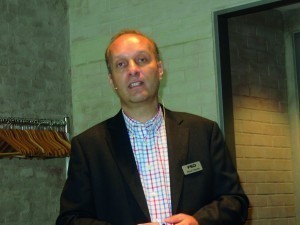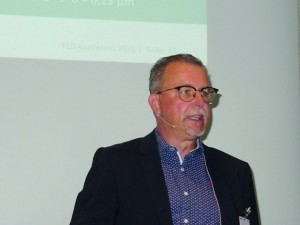At last, there was face-to-face networking in the industry again: the 29th FED Conference on September 16 and 17, 2021 in Bamberg was not only successful for this reason. It offered a lot of professional input with a view to the future.
More than 250 people took part in the conference. The organizer Fachverband für Design, Leiterplatten- und Elektronikfertigung (FED) drew a consistently positive conclusion: "The atmosphere among participants, exhibitors and speakers was extremely good. You could literally feel the joy of finally being able to exchange ideas live again after a long time," said Christoph Bornhorn, FED Managing Director.
"You could literally feel the joy of finally being able to exchange ideas live again after a long time"
The motto of the conference was 'Sustainable and successful: design, manufacturing and management processes in a new world of work' and offered a varied lecture program with a number of highlights as well as an accompanying exhibition and an evening event. For the first time, there were two keynotes - one at the opening and one at the closing. In addition, the 29th general meeting of the FED took place on the evening before the conference.
Gerhard Gröner appointed honorary member
Gerhard Gröner was made an honorary member at the general meeting. He was involved in the development of the basic course for PCB designers, the basis for the first official IPC Certified Interconnect Designer (CID) examination. Gerhard Gröner was also instrumental in setting up the FED training program for designers 'Certified Electronics Designer (ZED)'. He also established the additional training program for certified FED designers at technical and vocational colleges. After serving on the FED board and other committees, he is still actively involved in the management of the Nuremberg regional group and in the project group for recruiting young talent. With this enduring and wide-ranging commitment to the association, he has distinguished himself in particular and more than earned his honorary membership.
The exhibitors - design service providers, PCB manufacturers, EMS companies, software providers and suppliers for electronics manufacturing - were pleased to be able to present their products and services 'in real time' again
Opening keynote 'No Limits - How do I achieve my goal?
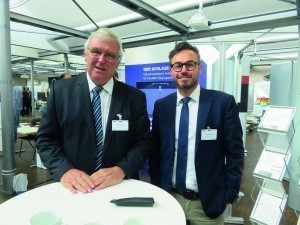 The conference was officially opened and welcomed by FED Chairman Prof. Dr. Rainer Thüringer, who briefly outlined the current situation and the program before moving on to the first keynote.
The conference was officially opened and welcomed by FED Chairman Prof. Dr. Rainer Thüringer, who briefly outlined the current situation and the program before moving on to the first keynote.
In the keynote speech 'No Limits - How do I achieve my goal?', entrepreneur and extreme athlete Joey Kelly described in his gripping way how he has mastered the greatest challenges of his career. He covered everything from his childhood, when the Kelly Family were still busking through Europe, to the race to the South Pole and his tour across Germany on foot and without any means. "The money is on the street," Joey Kelly quoted his father Dan Kelly and concluded: "The whole of life is a marathon." Because willpower, endurance and passion are required everywhere.
Several highlights
The keynote speech motivated everyone for the specialist conference, which comprised a total of 52 specialist presentations in four parallel workshop sessions. Experts reported on current challenges, developments and trends in the electronics industry. One focus was on the topic of sustainability, which was examined from many angles: from material selection and climate-neutral production to the recycling and reuse of raw materials, components and assemblies. The following selection of presentations illustrates the diversity.
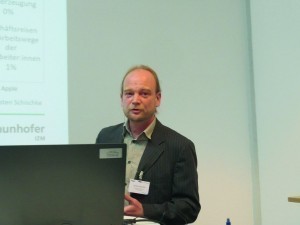 Karsten SchischkeKarstenSchischke, Fraunhofer IZM, Berlin, described the path from climate-neutral production to climate-neutral products: improving theCO2 balance by including the supply chain. Climate protection and climate neutrality are now among the priorities of many companies. However, taking the entire supply chain (Scope 3) into account is a particular challenge. Karsten Schischke used examples to show howCO2 emissions can be recorded in the complex supply chain. He explained which factors need to be taken into account and where estimates are initially sufficient. The PCB design is often of particular relevance, as are the suppliers' production sites. Semiconductor components generally make a significant contribution to the environmental impact - however, the scope for SMEs to influence this is clearly limited. A differentiated approach is required for other components. In the case of housing materials, switching to recycled materials can improve the life cycle assessment. As part of the Ministry of the Environment's climate protection initiative, Fraunhofer IZM offers individual pilot companies support in evaluating suppliers and the supply chain.
Karsten SchischkeKarstenSchischke, Fraunhofer IZM, Berlin, described the path from climate-neutral production to climate-neutral products: improving theCO2 balance by including the supply chain. Climate protection and climate neutrality are now among the priorities of many companies. However, taking the entire supply chain (Scope 3) into account is a particular challenge. Karsten Schischke used examples to show howCO2 emissions can be recorded in the complex supply chain. He explained which factors need to be taken into account and where estimates are initially sufficient. The PCB design is often of particular relevance, as are the suppliers' production sites. Semiconductor components generally make a significant contribution to the environmental impact - however, the scope for SMEs to influence this is clearly limited. A differentiated approach is required for other components. In the case of housing materials, switching to recycled materials can improve the life cycle assessment. As part of the Ministry of the Environment's climate protection initiative, Fraunhofer IZM offers individual pilot companies support in evaluating suppliers and the supply chain.
Another highlight was the presentation by Kay Ullrich, TITV e. V., Greiz, on the environmental sin Smart Textiles? - How modular systems make intelligent textiles repairable and recyclable. Up to now, smart textiles have mostly been special solutions that are not compatible with other items and can hardly be repaired. As the special materials they contain are difficult to separate, this results in waste contamination. Kay Ullrich explained how smart textiles can be systematically designed in such a way that they can be repaired and recycled and can also be produced more sustainably. Possible ways of achieving this include reinforced conductor structures for longer-lasting reliability or selective metallization only at the contacted points in the textile. A modular design concept also makes it possible for smart textiles to be sorted and dismantled after their service life and for the components to be separated. Work is now underway on how sustainable smart textiles can also be manufactured economically.
Patrick Franken, Aisler B. V., Aachen, spoke about crisis-proof procurement management and what needs to be considered when it comes to multi-vendor sourcing. The secure organization of supply chains is one of the biggest challenges in the realization of electronic assemblies. This is because the large number of different components required and the large number of possible suppliers result in a high level of complexity. However, this also opens up the possibility of multi-vendor sourcing. Due to unpredictable external influences, securing supply chains is more important today than ever before. Patrick Franken used the components, printed circuit boards and SMT printing stencils as examples to show what precautions need to be taken in order to be as free as possible in the selection of suppliers and how existing suppliers can be better integrated.
Björn Lampe, proAlpha Consulting GmbH, Weilerbach, and Kevin Decker-Weiss, CircuitByte GmbH, Darmstadt, explained Supply Chain 4.0 - How your ERP system can become a digital buyer. To calculate electronic assemblies, parts lists and possibly CAD data must be prepared in a wide variety of formats and price and availability data must be determined. With the BOM Connector from CircuitByte, parts lists can be prepared, purchasing data can be queried online and the calculation can be carried out. Manually entering master data into an ERP system in order to purchase the required components and manufacture the end product according to the BOM is also time-consuming. With a bidirectional connection between the BOM Connector and proAlpha, customer data, parts masters, manufacturer and supplier part numbers, prices and the BOM can be exchanged between the systems in real time, as Björn Lampe and Kevin Decker-Weiss demonstrated. ProAlpha also transfers further information such as product characteristics and inventory data to the BOM Connector. This makes work considerably easier and increases efficiency when calculating and preparing quotations.
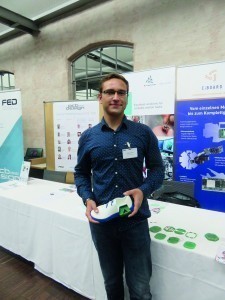 Award winner Philipp Lorenz provided information about his project and showed the running shoes at the exhibitionThecompliance requirements are becoming increasingly complex. Helmut Krautwurm, Bay-Soft GmbH, Obernzell, showed that and how the requirements regarding obsolescence, PCN, SCIP, REACh, China RoHS, EPUP, FIT, POP regulations and best price research ... can be met with automation. Data management with Excel is no longer sufficient and it is becoming increasingly time-consuming to research technical and commercial specifications in external systems such as SiliconExpert and distributor portals and enter them in your own systems. Automation of the component database or PDM is necessary in order to minimize the manual maintenance effort. Helmut Krautwurm listed the requirements for an automated PDM. In addition to an up-to-date article master without duplicates, this includes the management of technical specifications, packaging, environmental parameters, conflict minerals, risk analyses, documents on the company's own SQL servers as well as integrated PCN management and BOM checks with regard to RoHS, REACh, EOL, availability, prices, etc. Bay-Soft offers the Bay-2 PDM & Quote software designed for OEM and EMS companies, which manages all the required information as an automated product database and automatically updates the component master data via API connections to external systems and the ERP system. The integrated Best Price Engine also has access to the distributors' data via API. This means that prices and availability can be researched and imported in real time.
Award winner Philipp Lorenz provided information about his project and showed the running shoes at the exhibitionThecompliance requirements are becoming increasingly complex. Helmut Krautwurm, Bay-Soft GmbH, Obernzell, showed that and how the requirements regarding obsolescence, PCN, SCIP, REACh, China RoHS, EPUP, FIT, POP regulations and best price research ... can be met with automation. Data management with Excel is no longer sufficient and it is becoming increasingly time-consuming to research technical and commercial specifications in external systems such as SiliconExpert and distributor portals and enter them in your own systems. Automation of the component database or PDM is necessary in order to minimize the manual maintenance effort. Helmut Krautwurm listed the requirements for an automated PDM. In addition to an up-to-date article master without duplicates, this includes the management of technical specifications, packaging, environmental parameters, conflict minerals, risk analyses, documents on the company's own SQL servers as well as integrated PCN management and BOM checks with regard to RoHS, REACh, EOL, availability, prices, etc. Bay-Soft offers the Bay-2 PDM & Quote software designed for OEM and EMS companies, which manages all the required information as an automated product database and automatically updates the component master data via API connections to external systems and the ERP system. The integrated Best Price Engine also has access to the distributors' data via API. This means that prices and availability can be researched and imported in real time.
Diverse lecture program - topics range from design and components to software and management
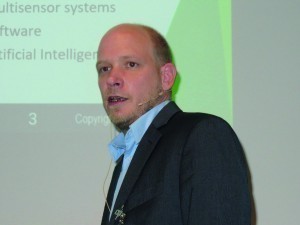 Gerd-Hendrik Greiwe, XRAY-LAB GmbH & Co. KG, provided information on automatic image evaluation using software for the X-ray inspection of BGAs
Gerd-Hendrik Greiwe, XRAY-LAB GmbH & Co. KG, provided information on automatic image evaluation using software for the X-ray inspection of BGAs
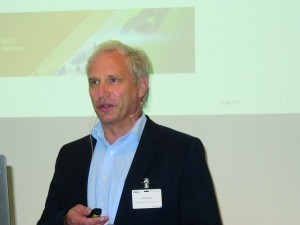 Olaf Römer, ATEcare Service GmbH & Co. KG, discussed the implementation options for the Smart Electronic Factory
Olaf Römer, ATEcare Service GmbH & Co. KG, discussed the implementation options for the Smart Electronic Factory
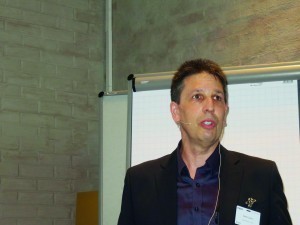 Martin Sachs, db electronic Daniel Böck GmbH, discussed the possible forms of delivery of printed circuit boards with regard to further processability
Martin Sachs, db electronic Daniel Böck GmbH, discussed the possible forms of delivery of printed circuit boards with regard to further processability
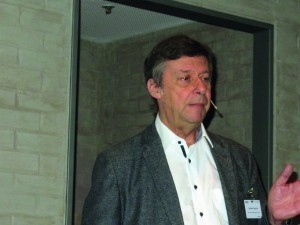 Raphael Podgurski, abp Automationssysteme GmbH, provided information on optimization strategies for material handling in production in the age of Industry 4.0
Raphael Podgurski, abp Automationssysteme GmbH, provided information on optimization strategies for material handling in production in the age of Industry 4.0
Award recognitions at the evening event
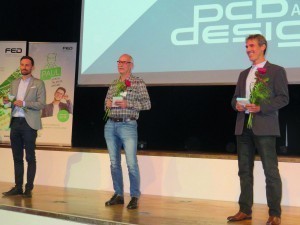 Winners of the PCB Design Award 2020Theevening of the first day of the conference was a time for celebration: The FED honored the winners of the PCB Design Award 2020 and the PAUL Award 2020, who could not be honored in front of an audience last year.
Winners of the PCB Design Award 2020Theevening of the first day of the conference was a time for celebration: The FED honored the winners of the PCB Design Award 2020 and the PAUL Award 2020, who could not be honored in front of an audience last year.
Young tech talents from the fields of Smart Home and Smart Clothes competed for the PAUL Award. The winners are:
- Paul Goldschmidt (18 years old) with the project 'Open source sensor system for temperature monitoring of liquids'
- Lukas Biethan (19 years old, team of 3) with the project 'Lora Sense (Long Range) for monitoring cellars'
- Philipp Lorenz (22 years old) with the project 'Technology Study: Energy Harvesting in Running Shoes'.
The PCB Design Award recognizes the complex work of PCB designers. The 2020 winners are:
- Thomas Blasko, CiBOARD electronic, with the project description for a system for laser scanner position measurement
- Georg Scheuermann, TQ-Systems, with computer-on-modules with various high-speed interfaces and memory blocks
- Michael Matthes, Wittenstein cyber motor, with the design for the alignment of nanosatellites in low-Earth orbit.
Closing keynote 'Beyond sustainability'
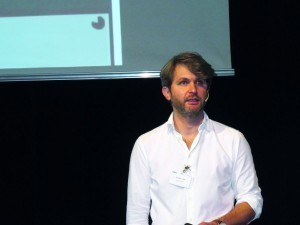 Andreas HuberAndreasHuber, Managing Director of the German Society Club of Rome, explained the global challenges of the 21st century and analyzed the reasons for undesirable developments in his closing keynote speech 'Beyond sustainability - Why sustainability doesn't just make ecological sense'. He showed how companies - even on a small scale - can get involved in reducingCO2 emissions. Andreas Huber addressed the aspects of sustainability declared by the UN and, with the facts he presented, made it clear that sustainability is not only ecological but also makes sense in general.
Andreas HuberAndreasHuber, Managing Director of the German Society Club of Rome, explained the global challenges of the 21st century and analyzed the reasons for undesirable developments in his closing keynote speech 'Beyond sustainability - Why sustainability doesn't just make ecological sense'. He showed how companies - even on a small scale - can get involved in reducingCO2 emissions. Andreas Huber addressed the aspects of sustainability declared by the UN and, with the facts he presented, made it clear that sustainability is not only ecological but also makes sense in general.
The 30th FED Conference will take place in Potsdam on September 29/30, 2022.




